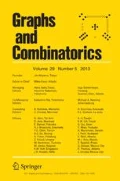Abstract
The concept of detecting arrays was developed to locate and detect interaction faults arising between the factors in a component-based system during software testing. In this paper, we propose a family of consecutive detecting arrays (CDAs) in which the interactions between factors are considered to be ordered. CDAs can be used to generate test suites for locating and detecting interaction faults between neighboring factors. We establish a general criterion for measuring the optimality of CDAs in terms of their size. Based on this optimality criterion, the equivalence between optimum CDAs and consecutive orthogonal arrays with prescribed properties is explored. Using the advantages of this equivalence, a great number of optimum CDAs are presented. In particular, the existence of optimum CDAs with few factors is completely determined.
Similar content being viewed by others
References
Bush, K.A.: A generalization of the theorem due to MacNeish. Ann. Math. Stat. 23, 293–295 (1952)
Bush, K.A.: Orthogonal arrays of index unity. Ann. Math. Stat. 23, 426–434 (1952)
Chateauneuf, M., Colbourn, C.J., Kreher, D.L.: Covering arrays of strength three. Des. Codes Cryptogr. 16(3), 235–242 (1999)
Chateauneuf, M., Kreher, D.L.: On the state of strength-three covering arrays. J. Combin. Des. 10(4), 217–238 (2002)
Chen, Y.: Constructions of Optimal Detecting Arrays of Degree 5 and Strength 2. Master’s Thesis, Soochow University (2011)
Colbourn, C.J.: Combinatorial aspects of covering arrays. LeMatematiche (Catania) 58, 121–167 (2004)
Colbourn, C.J.: Strength two covering arrays: existence tables and projection. Discret. Math. 308(5–6), 772–786 (2008)
Colbourn, C.J., Dinitz, J.H.: The CRC Handbook of Combinatorial Designs. CRC Press, Boca Raton (2007)
Colbourn, C.J., Martirosyan, S.S., Trung, T.V., Walker II, R.A.: Roux-type constructions for covering arrays of strengths three and four. Des. Codes Cryptogr. 41(1), 33–57 (2006)
Colbourn, C.J., McClary, D.W.: Locating and detecting arrays for interaction faults. J. Comb. Optim. 15(1), 17–48 (2008)
Godbole, A.P., Koutras, M.V., Milienos, F.S.: Consecutive covering arrays and a new randomness test. J. Statist. Plann. Inference 140(5), 1292–1305 (2010)
Godbole, A.P., Koutras, M.V., Milienos, F.S.: Binary consecutive covering arrays. Ann. Inst. Stat. Math. 63(3), 559–584 (2011)
Hartman, S.: On simple and supersimple transversal designs. J. Comb. Des. 8(5), 311–322 (2000)
Hartman, S., Raskin, L.: Problems and algorithms for covering arrays. Discret. Math. 284(1–3), 149–156 (2004)
Hedayat, A.S., Slone, N.J.A., Stufken, J.: Orthogonal Arrays. Springer, New York (1999)
Ji, L., Yin, J.: Constructions of new orthogonal arrays and covering arrays of strength three. J. Combin. Theory (A) 117(3), 236–247 (2010)
Jimenez, J.T., Marquez, I.I.: Covering arrays of strength three from extended permutation vectors. Des. Codes Cryptogr. 86(11), 2629–2643 (2018)
Kuhn, D. R., Reilly, M. J.: An investigation of the applicability of design of experiments to software testing. In: Proceedings of the 27th NASA/ IEEE Software Engineering Workshop, NASA Goddard Space Flight Center, pp. 91–95 (2002)
Kuhn, D.R., Wallace, D.R.: Software fault interaction and implication for software testing. IEEE Trans. Softw. Eng. 30(6), 1–4 (2004)
Raaphorst, S., Moura, L., Stevens, B.: Variable strength covering arrays. J. Combin. Des. 26(9), 417–438 (2018)
Rao, C.R.: Factorial experiments derivable from combinatorial arrangements of arrays. Suppl. J. R. Stat. Soc. 9, 128–139 (1947)
Shi, C., Tang, Y., Yin, J.: The equivalence between optimal detecting arrays and super-simple OAs. Des. Codes Cryptogr. 62(2), 131–142 (2012)
Shi, C., Yin, J.: Existence of super-simple \(\text{ OA }_\lambda (3,5, v)]^{\prime }\)s. Des. Codes Cryptogr. 72(2), 369–380 (2014)
Tang, Y., Yin, J.: Detecting arrays and their optimality. Acta Math. Sin. Engl. Ser. 27(12), 2309–2318 (2011)
Tzanakis, G., Moura, L., Panario, D., Stevens, B.: Covering arrays from \(m\)-sequences and character sums. Des. Codes Cryptogr. 85(3), 437–456 (2017)
Wang, Z., Nie, C., Xu, B., Shi, L.: Optimal test suite generation methods for neighbor factors combinatorial testing (in Chinese). Chin. J. Comput. 30(2), 200–211 (2007)
Acknowledgements
The authors would like to thank the anonymous referees for their helpful comments that much improved both the quality and readability of this paper. Our research is supported by Natural Science Foundation of China under Grant 11301342 and Natural Science Foundation of Shanghai under Grant 17ZR1419900.
Author information
Authors and Affiliations
Corresponding author
Additional information
Publisher's Note
Springer Nature remains neutral with regard to jurisdictional claims in published maps and institutional affiliations.
Appendix
Appendix
A simple \(\hbox {COA}_\lambda (2,5,6)\) with \(\lambda =3 \) or 5 is given below.
\(\lambda =3\), \(A=(A_1,A_2)^T\), where \(A_1\) and \(A_2\) are as follows.
\(\lambda =5\), \(B=(B_1,B_2,B_3)^T\), where \(B_1\), \(B_2\) and \(B_3\) are as follows.
Rights and permissions
About this article
Cite this article
Shi, C., Jiang, L. & Tao, A. Consecutive Detecting Arrays for Interaction Faults. Graphs and Combinatorics 36, 1203–1218 (2020). https://doi.org/10.1007/s00373-020-02176-7
Received:
Revised:
Published:
Issue Date:
DOI: https://doi.org/10.1007/s00373-020-02176-7
Keywords
- Consecutive detecting arrays
- Consecutive covering arrays
- Consecutive orthogonal arrays
- Optimality
- Equivalence



